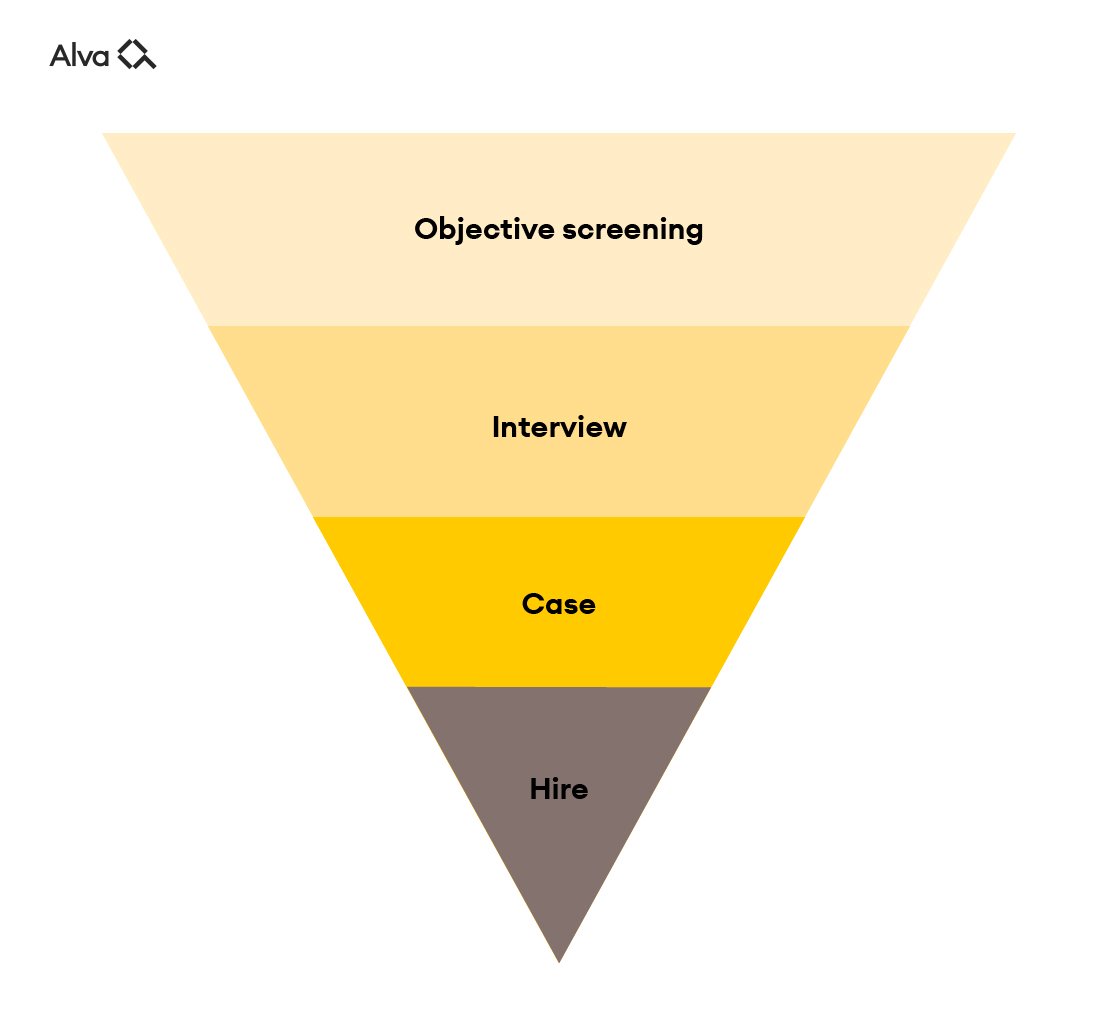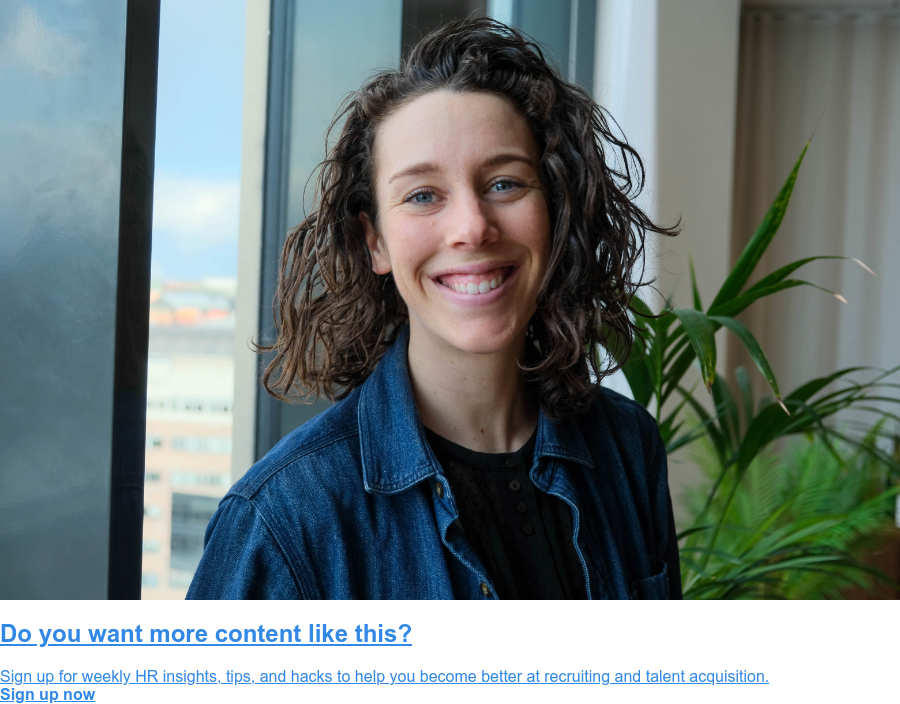A solid recruitment funnel isn't just helpful for talent teams who want to be more productive at work and improve communications with key stakeholders. It's a vital framework to deepen your pipeline with high-calibre candidates that can be interviewed, hired, and onboarded quickly.
However, too many talent teams now are attempting to cram as many applicants into the funnel as possible, regardless of quality or role fit. Subsequently, they lose sight of the fact that all you usually need is one great hire. What's more, many TA organisations still engage in outdated recruiting practices such as manually sourcing and cultivating prospects, which often lead to poor time-to-hire rates.
The lesson: Ensure you have a well-structured recruitment funnel in place that allows your TA team to move candidates along the pipeline effortlessly and land new hires with lightning speed.
Keep reading to learn how to maintain an end-to-end funnel that organically flows – from early attraction and sourcing to recruitment and final onboarding.
What is the recruitment funnel?
In a way, recruitment works like marketing. You convert candidates to hires the same way marketers convert leads to customers. The end goal here is to attract, convert and secure quality hires using a well-defined hiring framework – aka your recruitment funnel.
A defined funnel helps you narrow down your candidate pool until you are left with a new hire. Sourcing, screening, interviewing, and onboarding all contribute to a successful hiring funnel. However, the funnel can look vastly different from company to company, depending on various factors like the company's size and growth stage.
At Alva, we have a four-stage recruitment funnel.

Why the funnel matters
Let’s say it's taking you ages to source and pre-screen candidates for role fit. Or maybe your TA team is spending too much time at the interview stage. Having an optimised recruitment funnel can help you organise your entire hiring process from start to finish, ensuring your team operates with maximum efficiency.
What an optimised recruitment funnel can do:
- Breakdown your hiring process into defined stages, complete with strategies, goals, and actions defined at every level.
- Convert each stage into a set of tasks that can be assigned to team members.
- Improve your team's workflow for every new hire, ensuring everyone is on the same page.
- Optimise each stage of the funnel to keep candidates interested and connected with your brand.
- Offer an overview of your company's use of resources at each part of the funnel, and how this impacts ROI.
- Highlight what channels or tactics aren't working.
Recruitment funnel stages
Generally speaking, the recruitment funnel can be broken down into the following stages:
- Applicants enter the funnel: They've landed on your job ad, have been referred or contacted by a recruiter.
- Applications are submitted: Candidates have shown interest in the role and applied. Recruiters can then pick potential candidates from the talent pool by looking at their skill sets and culture fit.
- Screening: Shortlisted candidates get screened for the role through interviews. Unsuitable candidates get ruled out.
- An offer is made: The dream candidate has been chosen from the shortlist and an offer has been sent.
- New hire: The offer has been accepted and employment terms have been agreed upon.
- New employee is onboarded: The new employee is onboarded and starts working. This is where the hiring process is finalised.
Is your approach to hiring wrong?
Rather than treating recruitment as a numbers game, it's important to reflect and ask whether you have the mechanisms in place to guarantee a fair and objective screening process at every stage of your funnel.
“The problem of hiring is really becoming much, much harder. How do you spot performance when the hard skills, the things that were stable for so long, are changing?” - Malcolm Burenstam Linder, CEO of Alva Labs.
These days, many companies experience similar hiring challenges.
Pre-screening challenges:
- Large volume of applicants leads to hitches in processing and shortlisting candidates quickly enough.
- Lag time between application and communicating next steps can spur candidates to lose interest.
- Screening candidates based on the CV method can make you miss out on top talent and significantly narrow your candidate pool.
Potential solutions:
- Use an ATS to automatically sort through inbound applications at scale.
- Use recruitment software that automates email replies, thank you emails, and check-ins at scheduled intervals.
- Opt for data-led candidate assessments as the first step in your pre-screening phase, allowing you to hire candidates for their potential.
Interviewing challenges:
- How to overcome unconscious bias.
- How to account for potential skewed performance throughout interviews.
- Quality control for remote interviews.
Potential solutions:
- Use structured interviews to minimise bias and remain fair in your hiring process.
- Employ interview scorecards so that all candidates are assessed equally.
- Take the candidates' full profile into account, not just how they perform in an interview.
- Use quality video interviewing software to facilitate a good user experience.
Hiring challenges:
- Time it takes to draw up an appropriate job offer.
- Risk that the candidate will accept another job offer before signing with you.
- How to keep candidates engaged and committed to the position, from signing, to passing probation.
Potential solutions:
- Use templated job offers you customise and send for signing.
- Employ automated actions in your ATS to send job offers quickly.
- Ensure that the line of communication remains smooth all the way through the new employee's completed onboarding.
Overall, each stage of the recruitment funnel has its own set of tasks and challenges. When added up, these stages make up your entire hiring process, and when done well, can boost your company's ROI.
How to optimise your funnel
This is where the magic happens. This following section is split into three simple steps:
- Evaluate
- Measure
- Prioritise
1. Evaluate your current hiring efforts
Assessing the current state of your funnel can help you get a sense of how your TA team is faring and what areas of your recruitment process need improving.
Start by asking the following questions:
- Do you have a group of strong candidates to engage with?
- Are you meeting targets and measuring core metrics like time-to-hire, hiring velocity, and quality of hire?
- Is your employer branding on point?
- How streamlined is the application process?
- Is the candidate experience positive?
- Do qualified candidates move along the funnel quickly?
- Can you identify any loopholes in the hiring process?
- How many stages are there, from initial applicant engagement to hiring?
- How many new employees are regarded as quality hires by the TA team?
Pro tip: Try and revisit your funnel often, either bi-weekly or monthly, to gauge what's working and what needs changing. Gathering these insights can drastically improve your TA team´s performance as well as ensure your recruitment activities stay in top shape.
We personally went through this back in spring 2021. We were losing candidates at the first stage of the hiring process, so we had to go back and evaluate what we were doing wrong. And then we fixed it! Read our story here.
Optional exercise for your funnel:
Examine one of your job ads and then come up with a specific list of criteria for a made-up job position. Next slice half of your criteria. Your end-goal should always be to make everyone excited about applying and not make the process tedious or complicated.
Also, you don't want to create a long list of must-haves for a position, because this can easily lead to missing out on huge potential. Not to mention, a long ad with an extensive list of application requirements can be off-putting to applicants.
2.Measure performance with recruiting funnel metrics
It's astonishing how today, there are still very few employers who can pinpoint what channel produces the best candidates at the cheapest rate. This is because, simply put, they don't measure performance to begin with.
Start by taking a look at key performance metrics like candidate abandonment and completion rate, quality of candidate added to the pipeline, time to hire, quality of hire, and hiring velocity to get a sense of how you´re recruiting at every part of the funnel. Soon enough, you'll be able to get an idea of which sources produce the best results.
3. Prioritise the whole funnel
- Attract the right people from the get-go: If your goal is to land quality hires without burning through your company's resources, isn't it better to weed out candidates who are poor fits very early on? This will save your TA team time when it comes to screening candidates later for interviews. Try and go in the other direction, and create a smaller, but more qualified applicant pool to improve yield.
- Diversify the candidate pool: Reduce bias and discrimination in your hiring process by employing candidate assessments in the pre-employment screening phase. This will help you test profiles based on potential and culture fit, rather than their background, gender, age, or years of experience.
- Test candidates’ skills: In the recruitment world, there's consensus that testing to see whether the candidate has the right skills for the job pays off. A way to do this is to introduce a case study as a step in the application process.
- Hone your communication skills: Keep candidates engaged every step of the way, and never leave them in the dark. A candidate should never have to wait more than a few days to receive an update.
- Automate, automate, automate: Automate as much of your hiring process as possible, including your communications system, and cut back on time consuming manual labour like sifting through thousands of resumes.
- Design jobs with realistic requirements: Cut back on wishlists and jargon and incorporate gender-neutral terms in your job ads to make them more inclusive. Also be realistic about the requirements for the position.
- Measure results: As mentioned, measuring results can show you what's working and what isn´t. It's the only way to get a clear picture of where your team is at, and where you collectively need to go as an organisation.
- Revamp your interviewing process: Interviews are tricky, yet so important to get a feel for the candidate’s fit. Stick to questions that predict good hires by asking about past behaviour or performance that's relevant to job specifications. Also, ask the same questions to every candidate you're interviewing to lessen your chances of bias. Need help with structuring your interviews? Take a peek at our handy interviews template.
Final say
Getting better at hiring starts with understanding whether the candidates you select become good employees that stay on. If you don't know where you're going, the process can become chaotic.
An end-to-end-funnel is your roadmap to hiring better, as it treats recruitment as a full-scale cycle, rather than an isolated activity that starts early in the employee's journey. Having a well-structured funnel in place that connects all the dots together seamlessly –from early attraction and sourcing, to onboarding –can positively impact how you hire, improve your quality of hires, and make the whole hiring process run more smoothly
Optimise your hiring funnel with Alva
Looking to optimise your hiring process? Alva’s all-in-one software helps you to automate your screening process from start to finish, move candidates seamlessly along the pipeline, and improve the quality of your hires.
Ready to find your next hire efficiently? Start your free trial with Alva today.






